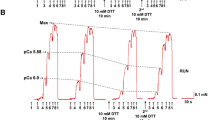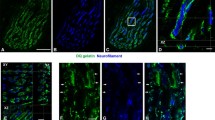Summary
Female Sprague-Dawley rats were subjected to a ten week training program to determine the influence of intense interval running on the fiber type composition of selected hindlimb muscles; soleus (S), plantaris (P), deep vastus lateralis (DVL), and superficial vastus lateralis (SVL). The muscles of one hindlimb were used for histochemical ATPase analysis to determine the distribution of fiber types and those of the contralateral hindlimb were assayed biochemically for citrate synthase activity (an aerobic marker). Training induced a significant increase in citrate synthase activity in each muscle section. The largest absolute increase occurred in the DVL and the largest relative increase occurred in the SVL. The distribution of fiber types within the S (85% slow-twitch) and SVL (100% fast-twitch) remained unchanged with training. However, significant increases in the percentage of type I (slow-twitch) fibers in both the P (2-fold) and DVL (3-fold) were observed with concomitant decreases in the type II (fast-twitch) population. In addition, training induced significant changes in the fast-twitch subtype populations of the DVL (IIB→IIA). These data suggest exercise-induced fiber type transformations occurring both within the fast-twitch population and between fast-twitch and slow-twitch fibers in certain hindlimb muscles of the rat following a high intensity interval training program.
Similar content being viewed by others
References
Andersen P, Henriksson J (1977) Training induced changes in the subgroups of human type II skeletal muscle fibers. Acta Physiol Scand 99:123–125
Ariano MA, Armstrong RB, Edgerton VR (1973) Hindlimb muscle fiber populations of five mammals. J Histochem Cytochem 21:51–55
Armstrong RB, Ogilvie RW, Schwane JA (1983) Eccentric exercise — induced injury to rat skeletal muscle. J Appl Physiol: 54:80–93
Baldwin KM, Klingerfuss GH, Terjung RL, Mole PA, Holloszy JO (1972) Respiratory capacity of white, red and intermediate muscle: adaptive response to training. Am J Physiol 222:373–378
Brooke MH, Kaiser KK (1970) Muscle fiber types: How many and what kind? Arch Neurol 23:369–379
Dudley GA, Abraham WM, Terjung RL (1982) Influence of exercise intensity and duration on biochemical adaptations in skeletal muscle. J Appl Physiol 53:844–850
Edgerton VR (1978) Mammalian muscle fiber types and their adaptability. Am Zool 18:113–125
Green HJ, Thomson JA, daub WP, Houston ME, Ranney DA (1979) Fiber composition, fiber size, and enzyme activities in vastus lateralis of elite athletes involved in high intensity exercise. Eur J Appl Physiol 41:109–118
Gollnick PD, Timson BF, Moore RL, Reidy M (1981) Muscular enlargement and number of fibers in skeletal muscles of rats. J Appl Physiol 50:936–943
Guth L, Samaha FJ (1969) Qualitative differences between actomyosin ATPase of slow and fast mammalian muscle. Exp Neurol 25:139–152
Guth L, Samaha FJ (1970) Procedure for the histochemical demonstration of actomyosin ATPase. Exp Neurol 28:365–367
Guth L, Yellin H (1971) The dynamic nature of so-called “fiber types” of mammalian skeletal muscle. Exp Neurol 31:277–300
Holloszy JO, Booth FW (1976) Biochemical adaptations to endurance exercise in muscle. Annu Rev Physiol 381:273–291
Howald H (1982) Training-induced morphological and functional changes in skeletal muscle. Int J Sports Med 3:1–12
Ingjer F (1979) Effects of endurance training on muscle fibre ATPase activity, capillary supply and mitochondrial content in man. J Physiol (Lond) 294:419–432
Jansson E, Sjödin B, Tesch P (1978) Changes in muscle fibre type distribution in man after physical training. A sign of fibre type transformation? Acta Physiol Scand 104:235–237
Jaweed MM, Herbison GJ, Ditunno JF (1977) Myosin ATPase activity after strengthening exercise. J Anat 124:371–381
Laughlin MH, Armstrong RB (1982) Muscular blood flow distribution patterns as a function of running speed in rats. Am J Physiol (Lond) 243:H296-H306
Laughlin MH, Armstrong RB (1983) Rat muscle blood flows as a function of time during prolonged slow treadmill exercise. Am J Physiol 244:H814-H824
Müller W (1974) Temporal progress of muscle adaptation to endurance training in hindlimb muscles of young rats. A histochemical and morphometrical study. Cell Tissue Res 156:61–88
Müntener M (1979) Variable pH dependence of the myosin-ATPase in different muscles of the rat. Histochemistry 62:299–304
Nemeth P, Pette D (1981a) The limited correlation of the myosin-based and the metabolic-based classifications of skeletal muscle fibres. J Histochem Cytochem 29:89–90
Nemeth P, Pette D (1981b) Succinate dehydrogenase activity in fibres classified by myosin ATPase in three hindlimb muscles of rat. J Physiol (Lond) 300:73–80
Noble EG, Dabrowski BL, Ianuzzo CD (1983) Myosin transformation in hypertrophied rat muscle. Pfluegers Arch 396:260–262
Peter JB, Barnard RJ, Edgerton VR, Gillespie CA, Stempel RE (1972) Metabolic profiles of three fibre types of skeletal muscle in guinea pigs and rabbits. Biochemistry (NY) 11:2627–2633
Pette D, Schnez U (1977) Coexistence of fast and slow type myosin light chains in single muscle fibres during transformation as induced by long term stimulation. FEBS Lett 83:128–130
Pierobon-Bormioli S, Sartore S, Libera LD, Vitadello M, Schiaffino S (1981) “Fast” isomyosins and fiber types in mammalian skeletal muscle. J Histochem Cytochem 29:1179–1188
Rubinstein H, Mabuchi K, Pepe F, Salmons S, Gergely J, Sréter FA (1978) Use of type-specific antimyosins to demonstrate the transformation of individual fibers in chronically stimulated rabbit fast muscles. J Cell Biol 79:252–261
Salmons S, Henriksson J (1981) The adaptive response of skeletal muscle to increased activity. Muscle Nerve 4:94–105
Schantz P, Billeter R, Henriksson J, Jansson E (1982) Training-induced increase in myofibrillar ATPase intermediate fibers in human skeletal muscle. Muscle Nerve 5:628–636
Shepherd RE, Gollnick PD (1976) Oxygen uptake of rats at different work intensities. Pfluegers Arch 362:219–222
Srere PA (1969) Citrate synthase. Methods Enzymol 230:946–950
Sullivan TE, Armstrong RB (1978) Rat locomotory muscle fiber activity during trotting and galloping. J Appl Physiol 44:358–363
Vrbová G (1979) Influence of activity on some characteristic properties of slow and fast mammalian muscles. Exerc Sports Sci Rev 7:181–213
Author information
Authors and Affiliations
Rights and permissions
About this article
Cite this article
Luginbuhl, A.J., Dudley, G.A. & Staron, R.S. Fiber type changes in rat skeletal muscle after intense interval training. Histochemistry 81, 55–58 (1984). https://doi.org/10.1007/BF00495401
Accepted:
Issue Date:
DOI: https://doi.org/10.1007/BF00495401




